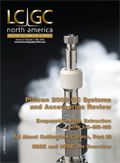The Acetonitrile Shortage: Blame Big Government?
LCGC North America
Without question, the current acetonitrile shortage has become the hottest topic in the chromatography world in recent memory. The influx of shortage-related articles, conservation tips, and even explorations of alternative separations instrumentation has been enormous at LCGC, with many brilliant and innovative ideas being presented to get laboratories through these hard times
Without question, the current acetonitrile shortage has become the hottest topic in the chromatography world in recent memory. The influx of shortage-related articles, conservation tips, and even explorations of alternative separations instrumentation has been enormous at LCGC, with many brilliant and innovative ideas being presented to get laboratories through these hard times
However, it is interesting that to date, so little attention has been paid to the underlying causes of this shortage, particularly in light of the large amounts of revenue that are tied to this seemingly innocuous solvent. Certainly, the reasons have been detailed, and the prevailing wisdom is that there are three: Hurricane Ike, the shutdown of one of the world's largest acetonitrile producers in China, and, perhaps most tellingly, the decrease in production of acrylonitrile by car manufacturers, as acetonitrile is a byproduct of acrylonitrile production.
It is that third cause that is especially troubling, as it cuts to the heart of the current global economic crisis and at the same time, draws a direct link to the chromatography community. It is generally agreed that the subprime mortgage crisis was what started the global economic snowball rolling downhill, and this directly led to the depression of countless other markets, including the automobile industry and its industrial byproducts — such as acetonitrile. But all too often, it as at this point that "general agreement" ends, and the cries of "Wall Street greed" and "predatory lending" begin, as critical thought often gives way to populist anger.
For if we really want to get to the heart of why car production ground to a halt in the past year and hence, why you are currently doing all you can to preserve acetonitrile every day in the lab, one more logical step must be taken, and the populist anger aimed one rung higher on the ladder. While it is true that there have been many greedy individuals and corporations who contributed to the current economic mess, blaming them alone is a little like blaming a toddler for coloring the walls with markers you opened, handed him, and then asked him to use.
With "Government Sponsored Entities," or GSEs, such Freddie Mac and Fannie Mae at the heart of the mortgage crisis, one has only to connect the dots back to the late-1990s when their fatally flawed lending policies were enacted. At that time, GSEs were actively encouraged (some might say pushed by threat of investigation) by the presidential administration and its congressional allies to make the risky loans that resulted in the current mess — all in the name of expanding the dream of homeownership to borrowers who otherwise could not qualify. Stunningly, many of those same congressional leaders and high-ranking administration figures are the ones now leading the chorus against corporate greed and doing the most finger-pointing, which takes more than a little chutzpah. If we were to list names here, they would probably fill a phone book, but it is fairly safe to start at the top and work your down through our current congressional leadership.
So while the chromatography community waits — like the rest of the world — for the economy to recover and thereby allow the acetonitrile to begin flowing again, perhaps it would be helpful to affix the bullseye to the correct group of villains. It may not bring about the recovery any faster, but it might just help determine who in Washington still has a job come November 2010.

David Walsh
David Walsh
Editor-in-Chief

New TRC Facility Accelerates Innovation and Delivery
April 25th 2025We’ve expanded our capabilities with a state-of-the-art, 200,000 sq ft TRC facility in Toronto, completed in 2024 and staffed by over 100 PhD- and MSc-level scientists. This investment enables the development of more innovative compounds, a broader catalogue and custom offering, and streamlined operations for faster delivery. • Our extensive range of over 100,000 high-quality research chemicals—including APIs, metabolites, and impurities in both native and stable isotope-labelled forms—provides essential tools for uncovering molecular disease mechanisms and exploring new opportunities for therapeutic intervention.
New Guide: Characterising Impurity Standards – What Defines “Good Enough?”
April 25th 2025Impurity reference standards (IRSs) are essential for accurately identifying and quantifying impurities in pharmaceutical development and manufacturing. Yet, with limited regulatory guidance on how much characterisation is truly required for different applications, selecting the right standard can be challenging. To help, LGC has developed a new interactive multimedia guide, packed with expert insights to support your decision-making and give you greater confidence when choosing the right IRS for your specific needs.

.png&w=3840&q=75)

.png&w=3840&q=75)



.png&w=3840&q=75)



.png&w=3840&q=75)










